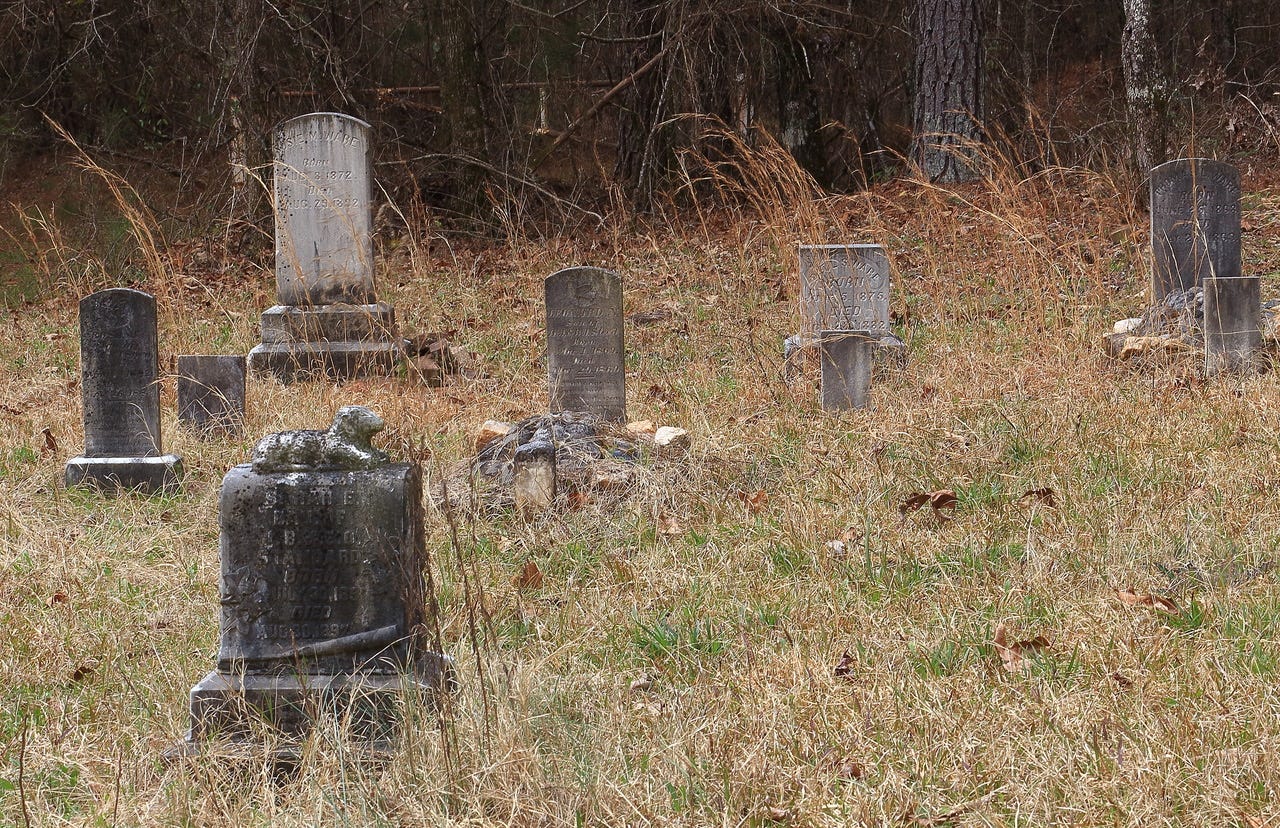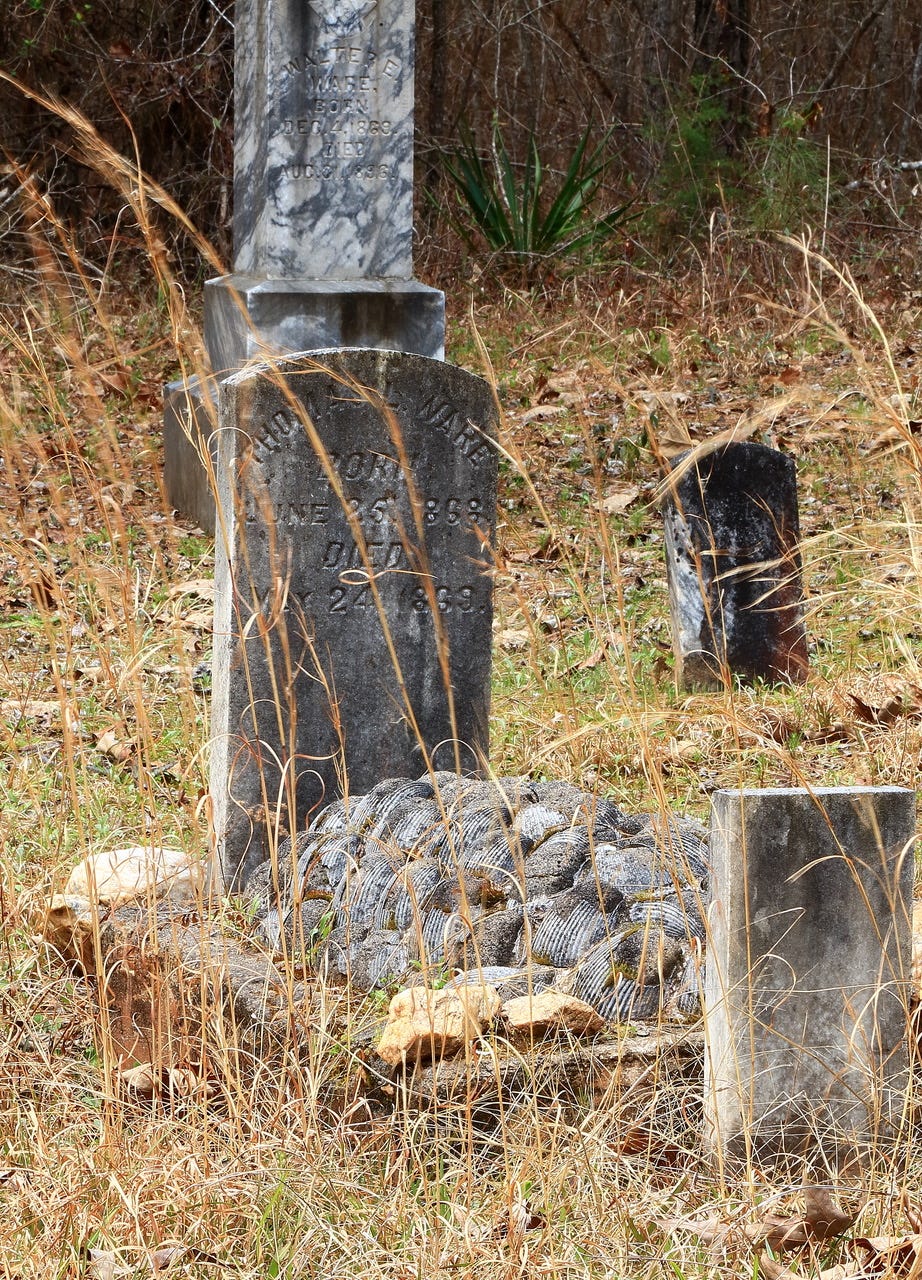Sleeping Beneath Seashells
Shell-covered graves are out there ... You’ll find them in a place called obscurity somewhere down a backroad
Photos and story by Tom Poland
Some of you share my interest in forgotten cemeteries. You write me and say so. You silent ones who don’t venture along the back roads would be surprised to see how many cemeteries hide in woods. When you see a clear-cut surrounding a stand of trees on a hill, chances are good a family plot lies there. I know because I’ve checked out many a copse and discovered secret family plots.
Yes, I visit old cemeteries whenever I can. Lest you think thoughts of death consume me, understand that I find cemeteries photogenic and a tonic to modern ills. Whenever I spend time in untended graveyards I discover sentiments and farewells mourners hoped someone would read. I read them and I come away a better man.
It’s easy for me to understand why a novelist might build a series of stories around cemeteries. That’s where we will all end up, be it beneath a granite stone, a slab, in an urn on a mantel—a one-man graveyard—or beneath some aspect of the natural world, a splendid cedar, for instance. When we’re finally there, when the roll is called up yonder, we’ll be, well, somewhere. I will be in a plot alongside family members just off Georgia Highway 220 in Lincoln County, Georgia.
A woman and I were talking about the urge to visit old graveyards.
“You know,” she said, “there’s one unassailable truth in this transient life.”
“What would that be?”
“If you want peace, go to a graveyard.”
She’s right. Yet again did I train my eyes on a place where people sleep the deep slumber of eternity. It was a Wilkes County cemetery whose location would be hard to find without a guide. My sister told me about this small cemetery deep in woods.
“You’ve got to see it,” she said.
We set out. Down a state highway into countryside we drove, then down an old road, and then a dirt road. There it was, the Ware Cemetery. Seashells covered two of its graves. Their grace and singularity struck me. I’ve seen solitary shells upon tombstones plenty of times. The last shell I saw atop a headstone was that of a famous Georgian’s. One white shell with a peach-bloom pink interior sat upon James Dickey’s grave in All Saints Episcopal Church Cemetery, Pawleys Island, South Carolina.
Another story. Some time back I reserved a room at the Marriott City Center down Macon way so I could visit Rose Hill Cemetery, the resting place of Greg and Duane Allman and Berry Oakley III. They sleep just west of the Ocmulgee River as it purls and winds its way seaward by way of a confluence with the Altamaha. I was curious to see where the men who gave fans “Melissa,” “Whipping Post,” “Dreams,” “Jessica,” and “Black Hearted Woman” slept, and I did.
Their resting place opened my eyes to the things people do as a way of paying respect to the departed. I’ve seen rocks and coins on gravesites, and once I saw a pile of devoured hickory nuts upon a tombstone, the accidental memorial of an epicurean gray squirrel. At Rose Hill I saw mushrooms and guitar picks on Duane and Greg Allmans’ gravesites. Not one seashell however.
That long Georgia dirt road we traveled? At its end I saw not one stone on a tombstone, not one guitar pick. I saw not one mushroom, but there were those two graves with dirt ridges, or mounds, encased in scallop shells. Cemented into place, the shells provided a protective cover, like a shingled roof, for a practical reason. Mounds of dirt distinguished some African-American graves. Problem was the mounds of fresh dirt washed away when deluges struck. A roof of shells, like house shingles, shunted away the water.
I looked into this custom and learned it was a practice in the South during Reconstruction. African Americans placed shells on graves and a few theories attempt to explain this tradition. One? Symbolism. The sea brought them to America and when they died the sea would return them to Africa. Shells symbolized the next great crossing as well, the one to the Promised Land, a more buoyant journey than the grimness of ferrying souls over the Styx to the underworld.
When it comes to sleeping beneath seashells, you’ll find seashell-covered graves in white cemeteries too. It’s believed poor whites took up the tradition. Layers of scallop





